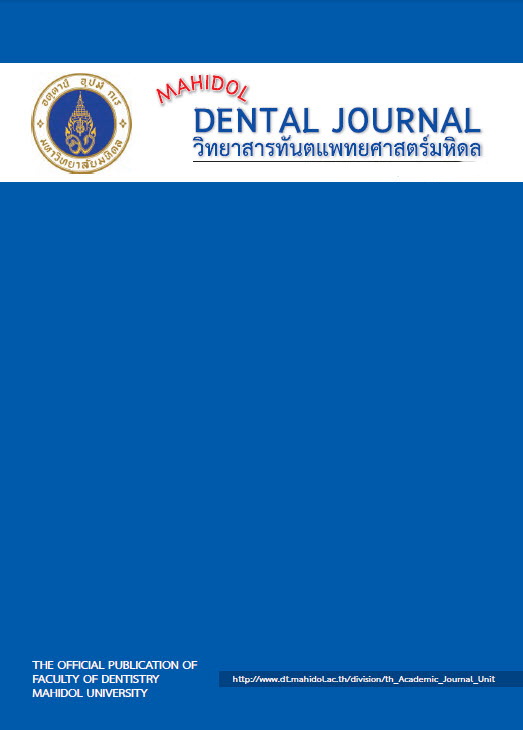Microleakage of endodontically treated tooth with post and core restoration materials using exposed and non-exposed intracanal post techniques
Main Article Content
Abstract
Objectives: This in vitro study aimed to investigate coronal microleakage of endodontically treated teeth restored with prefabricated fiber post and resin core materials using two different techniques at different water-exposing time periods.
Materials and methods: Eighty extracted human premolars were endodontically treated and randomly divided into eight groups of ten specimens each. The specimens of groups 1-4 were restored with prefabricated fiber post and core using exposed intracanal post technique, while the specimens of groups 5-8 were restored using non-exposed intracanal post technique. All specimens were thermocycled at different number of cycles representing water-exposing time periods of 1, 2, 4 weeks, and 6 months. After immersion in 2% Methylene blue for 48 hours, the specimens were subsequently cut into two halves longitudinally. The longitudinal sections were used for the measurement of dye infiltration along the interface using image analysis software. Mann-Whitney U-test and Kruskal Wallis test were performed to determine significant differences among microleakage of each group at a significant level of 0.05.
Results: Microleakage was measured with significant difference at the water-exposing time period of 6 months comparing two types of the post-core restoration technique (p = 0.02). Using exposed intracanal post technique, the specimens showed significant microleakage between the water-exposing time periods of 1 week and 6 months (p = 0.01); whereas, no significant difference of coronal microleakage was found among all groups using non-exposed intracanal post technique at different water-exposing time periods.
Article Details
References
2. Ray HA, Trope M. Periapical status of endodontically treated teeth in relation to the technical quality of the root filling and the coronal restoration. Int Endod J. 1995; 28: 12-8.
3. Ploumaki A, Bilkhair A, Tuna T, Stampf S, Strub JR. Success rates of prosthetic restorations on endodontically treated teeth; a systematic review after 6 years. J Oral Rehabil. 2013; 40: 618-30.
4. Lamichhane A, Xu C, Zhang FQ. Dental fiber-post resin base material: a review. J Adv Prosthodont. 2014; 6: 60-5.
5. Stankiewicz NR, Wilson PR. The ferrule effect: a literature review. Int Endod J. 2002; 35: 575-81.
6. Aksornmuang J, Foxton RM, Nakajima M, Tagami J. Microtensile bond strength of a dual-cure resin core material to glass and quartz fibre posts. J Dent. 2004; 32: 443-50.
7. Mannocci F, Sherriff M, Watson TF. Three-point bending test of fiber posts. J Endod. 2001; 27: 758-61.
8. Grandini S, Goracci C, Tay FR, Grandini R, Ferrari M. Clinical evaluation of the use of fiber posts and direct resin restorations for endodontically treated teeth. Int J Prosthodont. 2005; 18: 399-404.
9. Vano M G-GF, Goracci C, Vichi A, Ferrari M. Effects of oral environment and occlusal wear on FRC-posts integrity in clinical service for 5 years. J Adhes Dent. 2008; in press.
10. Lassila LV, Nohrstrom T, Vallittu PK. The influence of short-term water storage on the flexural properties of unidirectional glass fiber-reinforced composites. Biomaterials. 2002; 23: 2221-9.
11. Fox K, Gutteridge DL. An in vitro study of coronal microleakage in root-canal-treated teeth restored by the post and core technique. Int Endod J. 1997; 30: 361-8.
12. Gale MS, Darvell BW. Thermal cycling procedures for laboratory testing of dental restorations. J Dent. 1999; 27: 89-99.
13. Monticelli F, Goracci C, Ferrari M. Micromorphology of the fiber post-resin core unit: a scanning electron microscopy evaluation. Dent Mater. 2004; 20: 176-83.
14. Khamverdi Z, Abbasi S, Habibi E, Kasraei S, Azarsina M, Ebadi S. Effect of storage time on microtensile bond strength between quartz fiber post and composite core after different post surface treatments. J Conserv Dent. 2011; 14: 361-5.
15. Vichi A, Vano M, Ferrari M. The effect of different storage conditions and duration on the fracture strength of three types of translucent fiber posts. Dent Mater. 2008; 24: 832-8.
16. Martos J OP, Oliveira E, Castro LAS. hydrolytic degradation of composite resin: effects on the microhardness. Mater Research. 2003; 6: 599-604.
17. Camilotti V, Consalter AF, Dobrovolsk M, Bosquirolli V, Busato PR, Mendonca MJ. Microleakage of a self-adhesive resin cement after post cementation. Acta Odontol Latinoam. 2011; 24: 104-9.
18. Oliveira SG, Gomes DJ, Costa MH, Sousa ER, Lund RG. Coronal microleakage of endodontically treated teeth with intracanal post exposed to fresh human saliva. J Appl Oral Sci. 2013; 21: 403-8.
19. Sadighpour L, Rezaei S, Geramipanah F, Mohammadi M, Choubchian S. Comparison of two techniques for evaluation of coronal leakage along of a glass fiber post. J Dent (Tehran). 2010; 7: 124-31.
20. Fabianelli A PS, Davidson CL, Cagidiaco MC, Goracci C. the relevance of microleakage studies. Int Dent SA. 2007; 9: 64-74.
21. Tamse A, Katz A, Kablan F. Comparison of apical leakage shown by four different dyes with two evaluating methods. Int Endod J. 1998; 31: 333-7.
22. Ravanshad S, Ghoreeshi N. An in vitro study of coronal microleakage in endodontically-treated teeth restored with posts. Aust Endod J. 2003; 29: 128-33.


